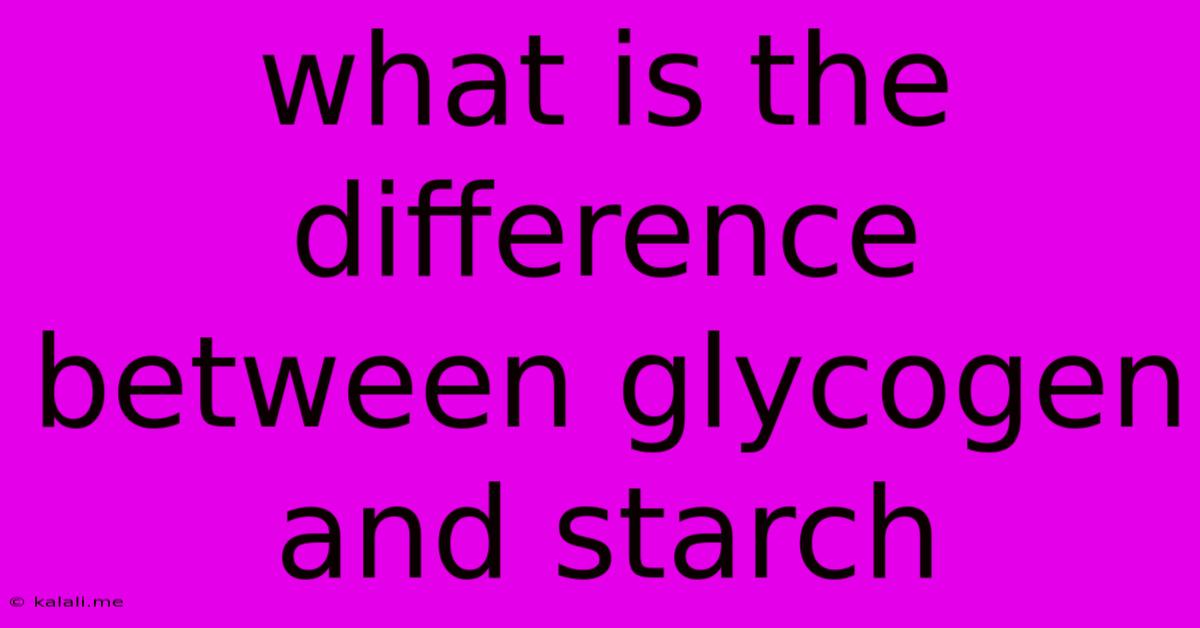What Is The Difference Between Glycogen And Starch
Kalali
Jun 15, 2025 · 3 min read

Table of Contents
What's the Difference Between Glycogen and Starch? A Deep Dive into Carbohydrate Storage
Understanding the differences between glycogen and starch is crucial for anyone interested in nutrition, biology, or even just curious about how our bodies and plants store energy. Both are polysaccharides – complex carbohydrates made up of long chains of glucose molecules – but they differ significantly in their structure, function, and location. This article will delve into the specifics, clarifying their distinctions and highlighting their key roles.
What is Glycogen?
Glycogen is the primary form of glucose storage in animals, including humans. Think of it as the body's readily available energy reserve. It's a highly branched polysaccharide, meaning its glucose chains are interconnected in a complex, tree-like structure. This branching allows for rapid breakdown and release of glucose when the body needs energy. Glycogen is predominantly stored in the liver and muscles. The liver glycogen acts as a glucose buffer, releasing glucose into the bloodstream to maintain blood sugar levels, while muscle glycogen serves as a direct energy source for muscle contraction.
Key Characteristics of Glycogen:
- Location: Primarily stored in the liver and muscles of animals.
- Structure: Highly branched polysaccharide of glucose units.
- Function: Short-term energy storage; readily available glucose source.
- Solubility: Insoluble in water.
- Branching: Leads to increased surface area, facilitating rapid enzymatic breakdown.
What is Starch?
Starch, on the other hand, is the main energy storage form in plants. It's the primary carbohydrate found in foods like potatoes, rice, corn, and wheat. Unlike glycogen, starch exists in two main forms: amylose and amylopectin. Amylose is a linear, unbranched chain of glucose units, while amylopectin is branched, though less extensively than glycogen. This structural difference affects how quickly starch is digested and absorbed.
Key Characteristics of Starch:
- Location: Stored in plants, primarily in seeds, roots, and tubers.
- Structure: Composed of amylose (linear) and amylopectin (branched) glucose chains.
- Function: Long-term energy storage in plants.
- Solubility: Insoluble in cold water, but partially soluble in hot water.
- Digestion: Digestion rate varies depending on the amylose/amylopectin ratio and the degree of branching.
Glycogen vs. Starch: A Comparison Table
| Feature | Glycogen | Starch |
|---|---|---|
| Location | Animal liver and muscles | Plant seeds, roots, and tubers |
| Structure | Highly branched | Amylose (linear), Amylopectin (branched) |
| Branching | Extensive | Less extensive than glycogen |
| Function | Short-term energy storage | Long-term energy storage |
| Digestibility | Rapidly digested and absorbed | Digestion rate varies |
| Solubility | Insoluble in water | Insoluble in cold water |
Conclusion:
While both glycogen and starch serve the vital function of energy storage, their differences in structure and location reflect their distinct roles in animal and plant metabolism. Understanding these differences provides a deeper appreciation for the intricate processes of energy storage and utilization in living organisms. This knowledge is beneficial for anyone seeking to optimize their diet and understand the impact of carbohydrates on their body's energy balance. Further research into specific carbohydrate metabolism can provide even greater insight into this fascinating topic.
Latest Posts
Latest Posts
-
A Piece Of Land Surrounded By Water On Three Sides
Jun 15, 2025
-
Least Common Multiple Of 3 4 And 7
Jun 15, 2025
-
Which Of The Following Is A Metaphor
Jun 15, 2025
-
What Is A Central Idea In This Passage
Jun 15, 2025
-
What Day Of The Week Is November 17
Jun 15, 2025
Related Post
Thank you for visiting our website which covers about What Is The Difference Between Glycogen And Starch . We hope the information provided has been useful to you. Feel free to contact us if you have any questions or need further assistance. See you next time and don't miss to bookmark.